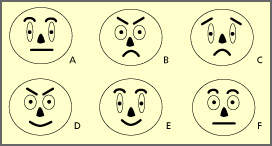

 TUTORIAL: INTERACTION AND RELATIONSHIPS
TUTORIAL: INTERACTION AND RELATIONSHIPSINTRODUCTION . NON-VERBAL COMMUNICATION . KINESICS . DISTANCE AND ARRANGEMENT . SPEECH ACTS . RELATIONSHIPS . KNOWING OTHERS . SELF-DISCLOSURE . PUNCTUATION . COORDINATED MANAGEMENT OF MEANING .
To speak, you have to address another or others. People in their right minds do not stray through the woods just talking at random to nobody. Even to talk to yourself you have to pretend that you are two people. - Walter Ong
Our human senses provide us with data from our environment. Within that data we discover patterns which invoke in our minds concepts that are given meaning in part by our personal experiences and in part by the social conventions of the groups in which we live.
While it is true that it is by means of communication that human beings express their inner selves, it is equally true that humans are only able to express themselves within the context of the societies in which they live. Similarly, while it is true that it is the social context that gives meaning to the thoughts, emotions and ideas of the individual members, it is equally true that human communication is the process that establishes and defines human societies.

However, scholars who try to move further in either of these two directions -- towards the self, or towards society -- find that they cannot. At least, they cannot and continue to study only communication. If the focus of study is refined to include only that which is internal, individual and private, then at some point the study will pass beyond the bounds of communication and into the provinces of psychology, cognitive studies, biology and the like. That is, it will lose the sense of "always being part of a group" that is essential to human communication.
Similarly, if the focus is only on that which is external, available and social, the study will cross into the provinces of sociology, political science, economics and the like,
and lose the aspect of communication which defines it as an activity whose source is found in
the thoughts and actions of individual human beings.
![]() 4001
4001
![]() 4002
4002
In this section we intend to take a look at this interactive aspect of human communication. We would like to understand how these interactions occur and how human relationships form and disperse. However, as we begin our investigation, we find ourselves faced with a vexing problem. Although a receiver might share one or more codes with a sender, and even though the receiver might be very close to, and even intimate with, the sender, the receiver has no way of directly experiencing the sender's self.
No matter how much effort one person might put into understanding another person's message, he or she can only receive it as a coded signal, and in their own minds receivers can only know what they decode the signal to mean.
Similarly, when a sender takes that which only he or she knows, and puts it forth to be noticed by others, no matter how much effort the sender puts into trying to share his or her experiences, it cannot be done directly -- messages must be encoded as signals before they can be sent.
Thus, even though people spend much of their time in the presence of others, they can never directly share each other's experiences, and so they can never know each other completely. This situation -- that no amount of communication can ever give one person complete knowledge of another -- makes for many surprises in life and is one of the reasons why the study of human relationships is so interesting.

Further, because human communication happens on many channels simultaneously and involves continual feedback, it is impossible to define one person as the sender and the other as the receiver. (You might recall that the Shannon/Weaver model was unable to explain this kind of interactive communication because of the complexity involved.)
The consequence of these two facts -- that humans cannot know each others' minds directly, and that the exchange of signals in human communication is extremely complex -- means that interpersonal communication is not so much a sending of clear, distinct messages as a continual interpretation of an ongoing stream of data in which the meanings of the messages are continually renegotiated by the participants. As one anthropologist put it
When we talk about communication we are not talking about a situation in which John acts and Mary reacts to John's action and in turn John reacts to Mary's action in some simple, ongoing, one-after-another sequence. Essentially, we discuss communication as a complex and sustaining system through which various members of the society interrelate with more or less efficiency and facility. According to communication theory, John does not communicate to Mary, and Mary does not communicate to John; Mary and John engage in communication. - Birdwhistle, 12
The word engagement is important, here, because It implies that communication is not only something that one human being does to others, but something that humans do together. Individuals use communication to explore, control and enjoy their environments, but just as truly, communication "uses" them as members of society.
This observation implies that in the presence of other people, everything that human beings say or do (including nothing) is noticed by others and has meaning to them. Consequently, every social situation involves communication. As an illustration of this, consider one particular kind of communication that humans use every day of their lives but seldom think about.
Non-verbal communication makes no use of the words, sentences, grammar and other structures that we associate with spoken and written language. The term "non-verbal" refers to a number of different communication processes -- gestures, facial expressions, odors, touch, and so on. The next few sections provide some examples of studies in non-verbal communication.
The term, kinesics (k' nees ix), was coined by anthropologist Ray Birdwhistell to describe the role of body movements in communication. It refers to gestures, posture, facial expressions and other bodily movements. Consider, for example, the gestures that we call "smile" and "frown."
Although the difference between a "smile" and a "frown" might seem to convey only a simple message, a small change in the arrangement of a speaker's, or listener's, face can dramatically alter the meaning of the words being exchanged.


What can be said about this conversation? It would seem that the two participants seem glad to see one another; that Carlos is looking forward to the party; that Merissa is disappointed that she won't be going; that Carlos is, too.
Now, consider the same conversation with different facial expressions.

In this case Merissa does not seem happy to see Carlos. And, she is not upset that she won't be going to the party. How do we know this? The answer is that we don't -- not 100% for sure -- but when humans perceive an expression that is interpreted as a smile, they usually take it to imply that a certain state of mind is present in its sender, and similarly with a frown. As babies, we begin to notice the attitudes of people around us when they smile and when they frown, and our life experiences from then on have reinforced those early interpretations.
Non-verbal communication is quite complex. In the prior examples communication occurs on two channels -- an aural channel that carries the spoken language, and a visual channel that carries the non-verbal facial expressions. However, even though it isn't marked, additional non-verbal communication is present. For example, the visual channel carries the hand gestures and body positions of the two participants, and the aural channel carries each speaker's tone of voice and the way each pauses and punctuates his and her speech. All of these play a part in the interaction between the two people.
Here is another example of the power of facial expression as communication media.

In
the first four faces, the only thing that changes is the placement
of the eyebrows. Yet, this single change dramatically alters the interpretation
of the "state of mind" of the individual behind the face. How do you "read"
each expression -- that is, what does the person's expression tell you about his or her state of mind? Notice that in face E, the eyelid has also moved. Does this make interpretation easier or more difficult?
![]() 4010
4010
In terms of the semiotic model facial expressions operate as indexes. That is, they are directly connected to the
emotions of the individual. Because of this, they are extremely powerful tools
for communication. For example, as the next quotation points out, eye contact
alone possesses considerable complexity.
![]() 4011
4011
Most encounters begin with eye contact. As an opening gesture, it has distinct advantages -- it can be so tentative that the looker need not own up and take responsibility for it, as he would have to if he spoke his greeting. Nevertheless, as Goffman has pointed out, once an American has allowed another to catch his eye, he's held to be open to whatever follows. That's why waitresses develop such skill at not allowing their eyes to be caught when they're particularly busy. Children learn this particular function of eye contact very early. When he was just two years old, my son, confined in a car seat and longing to complain, would keep turning his head to look at me but he wouldn't say a word until I allowed him to catch my eye. - Davis 1973, 69
As an example, consider the next set of faces in which the shape of the eyebrows, the shape of the eyes, and the shape of the mouth are all subject to change. The range of possible meanings is much larger than it was in the previous example.

Although much effort has gone into the study of facial expressions and other bodily movements, scholars are far from understanding this very complex means of communication. If you are interested in "body language, you can pursue your study through the many books and articles have been written about the subject.
The next section of this tutorial examines the role of position and distance in human communication.
![]() 4022
4022
![]() 4033
4033
![]() 4034
4034
![]() 4037
4037
For example, the arrangement by which people sit down around a table has much to do with the communication that follows. In the diagram below, the people seated at positions A and F are most likely to strike up a conversation, followed by the people at C and B (or D and F). Least likely to converse are the people at positions E and A or E and F.

While this seems to make a certain amount of sense, i.e., "closer together"
means "more likely to converse," other aspects of arrangement are more complex.
The angle and distance that people put between themselves in conversation often
indicates the closeness of their relationship, yet this distance varies from
one society to another.
![]() 4025
4025
![]() 4027
4027
![]() 4028
4028
![]() 4029
4029
In American society, for example, angle and distance often indicate the relationship of the participants and the intensity of their interaction. The next diagram shows three common conversational angles.

In the United States side-by-side conversation is usually the more impersonal -- as, for example, in the kind of conversation you might have with someone standing beside you in a crowd at a concert or while watching a parade.
People who arrange themselves at a 90 degree angle are more likely to interact with one another. This pattern is often seen in conversations at parties -- participants are able to interact with a certain amount of closeness, but they can also watch what is going on around them.
Face-to-face communication is the most private arrangement and it is
often associated with emotional expression. For example, people who are arguing will often place themselves face-to-face, as will close friends who are engaged in an intimate discussion.
![]() 4030
4030
![]() 4039
4039
The distance that two people put between them in face-to-face conversation varies considerably from one society to another. Some Mediterranean societies, for example, favor closeness, while some Asian societies favor greater distance.

Hall conducted extensive studies in the differences between American and Arab proxemics, noting, for example, that
... it used to puzzle me that a special Arab friend seemed unable to walk and talk at the same time. After years in the United States, he could not bring himself to stroll along, facing forward while talking. Our progress would be arrested while he edged ahead, cutting slightly in front of me and turning sideways so we could see each other. Once in this position, he would stop. His behavior was explained when I learned that for the Arabs to view the other person peripherally is regarded as impolite, and to sit or stand back-to-back is considered very rude. You must be involved when interacting with Arabs who are friends. - Hall 1969, 161
Proxemics includes many other aspects of nonverbal communication, including such as touching behavior, posture, odor, body heat, eye contact, and loudness or softness of speech. Because human beings cannot live other than together in the contexts of their societies, they must be continually aware of one another. And because in the presence of others such nonverbal acts as body movements, distances and arrangements, odors, eye contact and the like continually send messages whether we want them to or not.
This observation gives rise to the well known truism: "You can't NOT communicate." [Note]
![]() 4004
4004
![]() 4005
4005
![]() 4021
4021
![]() 4035
4035
![]() 4036
4036
![]() 4038
4038